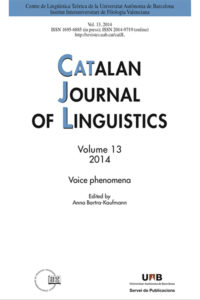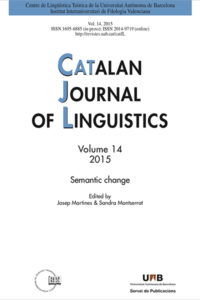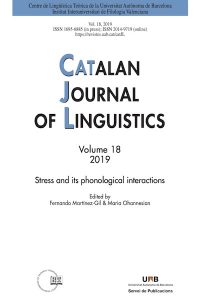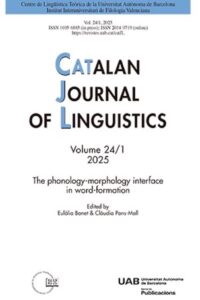15 setembre, 2019

Autors:
Eulàlia Bonet, Lisa Lai-Shen Cheng, Laura J. Downing i Joan Mascaró
Títol:
(In)direct Reference in the Phonology-Syntax Interface under Phase Theory: A Response to "Modular PIC" (D'Alessandro and Scheer 2015)Editorial: Linguistic Inquiry, vol.50(4). MIT Press
Data de publicació: Tardor de 2019
ISBN13: E-ISSN: 1530-9150
Més informacióAlthough in many interface theories, the domains of phrasal phonological processes are defined in terms of prosodic constituents, D’Alessandro and Scheer (2015) argue that their proposed modification of phase theory, Modular PIC, renders prosodic constituents superfluous. Phrasal phonological domains can instead be defined directly in the syntax. In this response, we argue that Modular PIC does not provide a convincing new approach to the syntax-phonology interface, as it is both too powerful and too restrictive. We show that the analysis offered of raddoppiamento fonosintattico in Eastern Abruzzese does not justify the loss of restrictiveness Modular PIC brings to phase theory. We also show that Modular PIC is too restrictive to account for phenomena, from Bantu languages and others, that have received satisfactory analyses within interface theories that appeal to prosodic constituents. We conclude that Modular PIC does not successfully replace prosodic constituent approaches to the interface.
10 gener, 2023
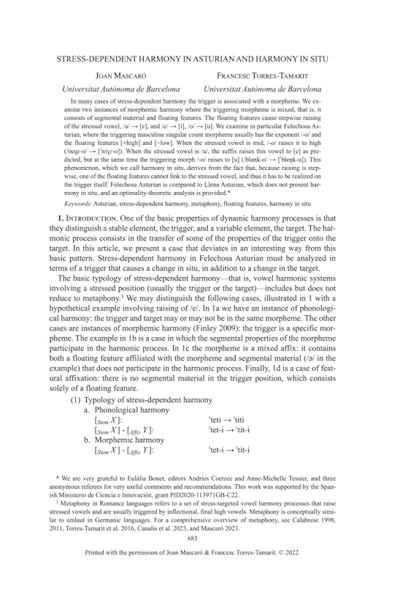
Autors:
Joan Mascaró & Francesc Torres-Tamarit
Títol:
Stress-dependent harmony in Asturian and harmony in situEditorial: Language, Linguistic Society of America
Data de publicació: Desembre del 2022
Pàgines: 33 Més informacióIn many cases of stress-dependent harmony the trigger is associated with a morpheme. We examine two instances of morphemic harmony where the triggering morpheme is mixed, that is, it consists of segmental material and floating features. The floating features cause stepwise raising of the stressed vowel, /a/ → [e], and /e/ → [i], /o/ → [u]. We examine in particular Felechosa Asturian, where the triggering masculine singular count morpheme usually has the exponent /-o/ and the floating features [+high] and [−low]. When the stressed vowel is mid, /-o/ raises it to high (/neɡɾ-o/ → [ˈniɣɾ-o]). When the stressed vowel is /a/, the suffix raises this vowel to [e] as predicted, but at the same time the triggering morph /-o/ raises to [u] (/blank-o/ → [ˈbleŋk-u]). This phenomenon, which we call harmony in situ, derives from the fact that, because raising is stepwise, one of the floating features cannot link to the stressed vowel, and thus it has to be realized on the trigger itself. Felechosa Asturian is compared to Ḷḷena Asturian, which does not present harmony in situ, and an optimality-theoretic analysis is provided.
6 febrer, 2017

Autors:
Mateu, Jaume & Renato Oniga (eds.)
Títol:
Generative Approaches to Latin SyntaxEditorial: Bellaterra: Servei de Publicacions de la UAB
Col·lecció: Catalan Journal of Linguistics #16Data de publicació: 2017
Pàgines: 216 Text completFifty years have passed since the first attempt to apply generative grammar methods to Latin syntax. The well-known book by Robin Tolmach Lakoff, published in 1968 by the MIT Press with the title of Abstract Syntax and Latin Complementation, was presented as a dissertation in linguistics at Harvard University in 1967, with the title of Studies in the Transformational Grammar of Latin. The Complement System. In order to celebrate its fiftieth anniversary, we thought it was appropriate to publish a collection of papers written by some distinguished specialists who approach the study of Latin syntax from a generative perspective. Their works show the important research that is being currently carried out in this active field. In this introduction, we would like to briefly trace the development of this research area, trying to emphasize elements of continuity, changes, results, and problems. Although generative grammar has provided very important contributions to phonology and morphology as well, it is nonetheless clear that, from the very beginning, its theoretical focus has been on syntax.
Títols de la col·lecció / Also in this series:
12 gener, 2018

Autors:
Jaume Mateu & Renato Oniga
Títol:
Lingue antiche e moderne, 9Editorial: Università degli Studi di Udine
Data de publicació: Setembre de 2020
ISBN13: 2281-4841
Més informacióWord formation in Latin is a fascinating subject that has been approached from different theoretical perspectives in recent decades. In this area there are some prominent topics that have captured the attention of various researchers.
Within the 20th International Colloquium on Latin Linguistics, held at the University of Las Palmas de Gran Canaria on 17-21 June 2019, we organized a workshop to congregate researchers who are working on word formation in Latin from different theoretical perspectives. Our goal was to begin a free and informal exchange of ideas in order to promote a fruitful cross-theoretical debate.
In this number of the journal we have collected a selection of the papers presented in the workshop. Each paper has been reviewed by two anonymous reviewers and we are very grateful to them for their efforts and help to improve the quality of the contributions. The papers offer different paths of argumentation and linguistic theorizing, which provide a substantial overview on the area of word formation in Latin today.
















